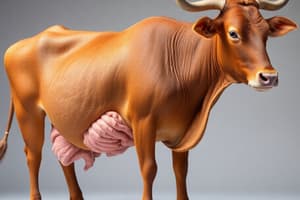Podcast
Questions and Answers
_______ consists of the enzymatic hydrolysis of large molecules into their monomeric building blocks.
_______ consists of the enzymatic hydrolysis of large molecules into their monomeric building blocks.
Digestion
Multicellular animals use an _______ canal for digestion.
Multicellular animals use an _______ canal for digestion.
alimentary
Ruminants are examples of _______ fermenters.
Ruminants are examples of _______ fermenters.
foregut
Design of the alimentary canal must match the quality of food that the animal _______.
Design of the alimentary canal must match the quality of food that the animal _______.
Gastrointestinal secretions include salivary glands, secretory cells in the stomach, and intestinal _______.
Gastrointestinal secretions include salivary glands, secretory cells in the stomach, and intestinal _______.
Dehydration and stress can reduce the flow of saliva, leading to _______ mouth.
Dehydration and stress can reduce the flow of saliva, leading to _______ mouth.
Hindgut fermenters like horses, elephants, and koalas have a digestive system that relies on fermentation in the ______
Hindgut fermenters like horses, elephants, and koalas have a digestive system that relies on fermentation in the ______
Ruminants, such as deer and cattle, have a unique digestive system with a ______-chambered stomach
Ruminants, such as deer and cattle, have a unique digestive system with a ______-chambered stomach
Foregut fermenters like camels and giraffes have a digestive system that includes a ______ for fermentation
Foregut fermenters like camels and giraffes have a digestive system that includes a ______ for fermentation
In the alimentary canal design of ruminants, the ______ and reticulum are responsible for initial breakdown of cellulose
In the alimentary canal design of ruminants, the ______ and reticulum are responsible for initial breakdown of cellulose
Gastrointestinal secretions in ruminants involve the ______ cells that secrete pepsinogen for protein digestion
Gastrointestinal secretions in ruminants involve the ______ cells that secrete pepsinogen for protein digestion
A cow with a fistula is used to monitor the digestive process in ______
A cow with a fistula is used to monitor the digestive process in ______
_________ is produced by the parietal cells
_________ is produced by the parietal cells
Parietal cells produce H+ in the gastric juice ________ times greater than in plasma
Parietal cells produce H+ in the gastric juice ________ times greater than in plasma
Enzyme carbonic anhydrase is used for the conversion of CO2 + H2O into ________
Enzyme carbonic anhydrase is used for the conversion of CO2 + H2O into ________
Pepsin, an endopeptidase, selectively cleaves ________ peptide bonds
Pepsin, an endopeptidase, selectively cleaves ________ peptide bonds
Goblet cells secrete mucus that coats the gastric epithelium and protects it from being digested in the ________
Goblet cells secrete mucus that coats the gastric epithelium and protects it from being digested in the ________
Absorption of nutrients in the intestine involves several transfer processes including ________ transport
Absorption of nutrients in the intestine involves several transfer processes including ________ transport
Flashcards are hidden until you start studying
Study Notes
Digestion and Alimentary Canal
- Digestion involves the enzymatic hydrolysis of large molecules into their monomeric building blocks.
- Multicellular animals use an alimentary canal for digestion, which must be designed to match the quality of food ingested.
Types of Digestive Systems
- Foregut fermenters: use an alimentary canal with a specialized foregut for fermentation, examples include ruminants.
- Hindgut fermenters: use an alimentary canal with a specialized hindgut for fermentation, examples include horses and elephants.
Salivary Glands and Saliva
- Saliva is a complex mixture that allows food to be tasted and has antibacterial action.
- Saliva contains lysozyme, which causes bacterial lysis, and lactoferrin, which removes free iron.
- Saliva also contains amylase, which initiates the digestion of carbohydrates.
- Humans produce approximately 1L of saliva per day, with flow varying according to the circadian rhythm.
- Dehydration and stress can reduce saliva flow, leading to a dry mouth.
Formation of Saliva
- Saliva is formed in the blind cavity (acini) of the salivary gland through active transport and osmosis.
- NaCl is secreted and H2O moves down the osmotic gradient into the acini.
- Amylase and glycoproteins (mucin) are added to the saliva through exocytosis.
Conditioned Reflex of Salivation
- Salivary secretions can be controlled by the brain through a conditioned reflex.
- Ivan Pavlov demonstrated this phenomenon in dogs, winning the Nobel Prize in 1904.
Digestive Secretions in Vertebrates
- Two mechanisms control digestive secretions in vertebrates: neuronal control and hormonal control.
The Monogastric Stomach
- The lining of the monogastric stomach features gastric pits, goblet cells that produce mucus, and gastric glands.
- Parietal cells in the gastric glands secrete HCl, while chief cells secrete pepsinogen.
Ruminant Mammals
- Ruminant mammals have a four-chambered stomach with an elaborate system for cellulose digestion.
- The rumen and reticulum contain prokaryotes and protists that break down cellulose.
- The animal periodically regurgitates its meal to soften the material (cud).
Multi-chambered Digestive Systems
- Multi-chambered digastric stomachs are found in herbivores such as deer, giraffes, and cattle.
- Symbiotic organisms carry out fermentation in the rumen, an anaerobic conversion process.
- The products of fermentation are absorbed into the bloodstream.
Hindgut Fermenters
- Hindgut fermenters include horses, elephants, and many rodents.
- Microorganisms in the cecum help break down cellulose, producing sugars and other nutrients.
Control of Gastrointestinal Secretions
- Gastric secretions are controlled by the production of HCl by parietal cells.
- HCl helps break peptide bonds, activates gastric enzymes, and kills microorganisms.
- Pepsin is the major enzyme produced by the stomach, which selectively cleaves inner peptide bonds.
Nutrient Uptake in the Intestine
- Absorption of nutrients involves several transfer processes, including simple diffusion, facilitated diffusion, cotransport, active transport, and endocytosis.
- The type of mechanism used depends on the type of molecule absorbed.
- Substances that diffuse across the apical membrane of the small intestine include fatty acids, monoglycerides, and cholesterol.
Studying That Suits You
Use AI to generate personalized quizzes and flashcards to suit your learning preferences.




